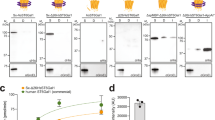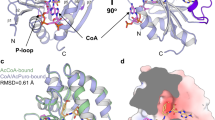Abstract
Engineering of glycosyltransferases (GTs) with desired substrate specificity for the synthesis of new oligosaccharides holds great potential for the development of the field of glycobiology. However, engineering of GTs by directed evolution methodologies is hampered by the lack of efficient screening systems for sugar-transfer activity. We report here the development of a new fluorescence-based high-throughput screening (HTS) methodology for the directed evolution of sialyltransferases (STs). Using this methodology, we detected the formation of sialosides in intact Escherichia coli cells by selectively trapping the fluorescently labeled transfer products in the cell and analyzing and sorting the resulting cell population using a fluorescence-activated cell sorter (FACS). We screened a library of >106 ST mutants using this methodology and found a variant with up to 400-fold higher catalytic efficiency for transfer to a variety of fluorescently labeled acceptor sugars, including a thiosugar, yielding a metabolically stable product.
This is a preview of subscription content, access via your institution
Access options
Subscribe to this journal
Receive 12 print issues and online access
$259.00 per year
only $21.58 per issue
Buy this article
- Purchase on Springer Link
- Instant access to full article PDF
Prices may be subject to local taxes which are calculated during checkout





Similar content being viewed by others

References
Crocker, P.R. & Feizi, T. Carbohydrate recognition systems: functional triads in cell-cell interactions. Curr. Opin. Struct. Biol. 6, 679–691 (1996).
Rudd, P.M., Elliott, T., Cresswell, P., Wilson, I.A. & Dwek, R.A. Glycosylation and the immune system. Science 291, 2370–2376 (2001).
Lowe, J.B. Glycan-dependent leukocyte adhesion and recruitment in inflammation. Curr. Opin. Cell Biol. 15, 531–538 (2003).
Sacks, D. & Kamhawi, S. Molecular aspects of parasite-vector and vector-host interactions in leishmaniasis. Annu. Rev. Microbiol. 55, 453–483 (2001).
Qasba, P.K., Ramakrishnan, B. & Boeggeman, E. Substrate-induced conformational changes in glycosyltransferases. Trends Biochem. Sci. 30, 53–62 (2005).
Arnold, F.H., Wintrode, P.L., Miyazaki, K. & Gershenson, A. How enzymes adapt: lessons from directed evolution. Trends Biochem. Sci. 26, 100–106 (2001).
Tao, H. & Cornish, V.W. Milestones in directed enzyme evolution. Curr. Opin. Chem. Biol. 6, 858–864 (2002).
Dalby, P.A. Optimising enzyme function by directed evolution. Curr. Opin. Struct. Biol. 13, 500–505 (2003).
Goddard, J.P. & Reymond, J.L. Enzyme assays for high-throughput screening. Curr. Opin. Biotechnol. 15, 314–322 (2004).
Aharoni, A., Griffiths, A.D. & Tawfik, D.S. High-throughput screens and selections of enzyme-encoding genes. Curr. Opin. Chem. Biol. 9, 210–216 (2005).
Becker, S., Schmoldt, H.U., Adams, T.M., Wilhelm, S. & Kolmar, H. Ultra-high-throughput screening based on cell-surface display and fluorescence-activated cell sorting for the identification of novel biocatalysts. Curr. Opin. Biotechnol. 15, 323–329 (2004).
Griffiths, A.D. & Tawfik, D.S. Directed evolution of an extremely fast phosphotriesterase by in vitro compartmentalization. EMBO J. 22, 24–35 (2003).
Harduin-Lepers, A. et al. The human sialyltransferase family. Biochimie 83, 727–737 (2001).
Chiu, C.P. et al. Structural analysis of the sialyltransferase CstII from Campylobacter jejuni in complex with a substrate analog. Nat. Struct. Mol. Biol. 11, 163–170 (2004).
Antoine, T., Heyraud, A., Bosso, C. & Samain, E. Highly efficient biosynthesis of the oligosaccharide moiety of the GD3 ganglioside by using metabolically engineered Escherichia coli. Angew. Chem. Int. Edn. Engl. 44, 1350–1352 (2005).
Aharoni, A., Amitai, G., Bernath, K., Magdassi, S. & Tawfik, D.S. High-throughput screening of enzyme libraries: thiolactonases evolved by fluorescence-activated sorting of single cells in emulsion compartments. Chem. Biol. 12, 1281–1289 (2005).
Gosselin, S., Alhussaini, M., Streiff, M.B., Takabayashi, K. & Palcic, M.M. A continuous spectrophotometric assay for glycosyltransferases. Anal. Biochem. 220, 92–97 (1994).
Fernandez-Gacio, A., Uguen, M. & Fastrez, J. Phage display as a tool for the directed evolution of enzymes. Trends Biotechnol. 21, 408–414 (2003).
Varadarajan, N., Gam, J., Olsen, M.J., Georgiou, G. & Iverson, B.L. Engineering of protease variants exhibiting high catalytic activity and exquisite substrate selectivity. Proc. Natl. Acad. Sci. USA 102, 6855–6860 (2005).
Mastrobattista, E. et al. Discovering novel evolutionary pathways to β-galactosidases using in vitro compartmentalization and fluorescence activated sorting of double emulsions. Chem. Biol. 12, 1291–1300 (2005).
Kim, Y.W., Lee, S.S., Warren, R.A. & Withers, S.G. Directed evolution of a glycosynthase from Agrobacterium sp. increases its catalytic activity dramatically and expands its substrate repertoire. J. Biol. Chem. 279, 42787–42793 (2004).
Lin, H., Tao, H. & Cornish, V.W. Directed evolution of a glycosynthase via chemical complementation. J. Am. Chem. Soc. 126, 15051–15059 (2004).
Witczak, Z.J. & Culhane, J.M. Thiosugars: new perspectives regarding availability and potential biochemical and medicinal applications. Appl. Microbiol. Biotechnol. 69, 237–244 (2005).
Rich, J.R., Szpacenko, A., Palcic, M.M. & Bundle, D.R. Glycosyltransferase-catalyzed synthesis of thiooligosaccharides. Angew. Chem. Int. Edn. Engl. 43, 613–615 (2004).
Karwaski, M.F., Wakarchuk, W.W. & Gilbert, M. High-level expression of recombinant Neisseria CMP-sialic acid synthetase in Escherichia coli. Protein Expr. Purif. 25, 237–240 (2002).
Vartanian, J.P., Henry, M. & Wain-Hobson, S. Simulating pseudogene evolution in vitro: determining the true number of mutations in a lineage. Proc. Natl. Acad. Sci. USA 98, 13172–13176 (2001).
Acknowledgements
We are grateful to A. Johnson for his devoted assistance with the FACS. We thank E. Samain for his provision of JM107 Nan A− cells. A.A. is supported by a long term fellowship from the Human Frontiers Science Program (HFSP), K.T. by a Deutscher Akademischer Austausch Dienst (DAAD) fellowship, S.B. by a Swiss National Science Foundation Fellowship, C.P.C.C. by a Canadian Institutes for Health Research (CIHR) and Michael Smith Foundation for Health Research (MSFHR) fellowships, and L.L.L. by Natural Sciences and Engineering Research Council (NSERC) and MSFHR fellowships. We thank the Canadian Institutes for Health Research, the Howard Hughes Medical Institute (to N.C.J.S.) and the Natural Sciences and Engineering Research Council of Canada for financial support.
Author information
Authors and Affiliations
Contributions
A.A. conceived the strategy and carried out the majority of the work. K.T., S.B., L.L.L. and H.C. carried out the synthesis. C.P.C.C. and N.C.J.S. carried out the crystallography. W.W.W. and S.G.W. helped in development of the strategy. A.A. and S.G.W. wrote the manuscript.
Corresponding author
Ethics declarations
Competing interests
The authors declare no competing financial interests.
Supplementary information
Supplementary Fig. 1
Reaction scheme for 〈-2,3 sialyltransferase Cst-II. (PDF 74 kb)
Supplementary Fig. 2
FACS density plots. (PDF 426 kb)
Supplementary Fig. 3
Activity analysis by TLC of the best four clones isolated following three rounds of FACS enrichment of the Cst-II library relative to the wt Cst-II. The (PDF 256 kb)
Supplementary Fig. 4
Transfer activity analysis of CMP-Neu5Ac (1 mM) or CMP-KDN (5 mM) to bodipy-3SH-lactose or bodipy-lactose (0.5 mM) for different samples analysed by TLC. (PDF 145 kb)
Supplementary Table 1
Catalytic efficiency (kcat/KM) of wt Cst-II and F91Y mutant for the transfer of CMPNeu5Ac to different acceptors. (PDF 75 kb)
Supplementary Table 2
Data collection and refinement statistics. (PDF 92 kb)
Rights and permissions
About this article
Cite this article
Aharoni, A., Thieme, K., Chiu, C. et al. High-throughput screening methodology for the directed evolution of glycosyltransferases. Nat Methods 3, 609–614 (2006). https://doi.org/10.1038/nmeth899
Received:
Accepted:
Published:
Issue Date:
DOI: https://doi.org/10.1038/nmeth899
This article is cited by
-
Recent Advances in Rapid Screening Methods for Glycosyltransferases
Catalysis Letters (2024)
-
A high-throughput screening platform for enzymes active on mucin-type O-glycoproteins
Nature Chemical Biology (2023)
-
Cell-based high-throughput screening of polysaccharide biosynthesis hosts
Microbial Cell Factories (2021)
-
Directed evolution of Aspergillus oryzae lipase for the efficient resolution of (R,S)-ethyl-2-(4-hydroxyphenoxy) propanoate
Bioprocess and Biosystems Engineering (2020)
-
In vivo Protein Evolution, Next Generation Protein Engineering Strategy: from Random Approach to Target-specific Approach
Biotechnology and Bioprocess Engineering (2019)


